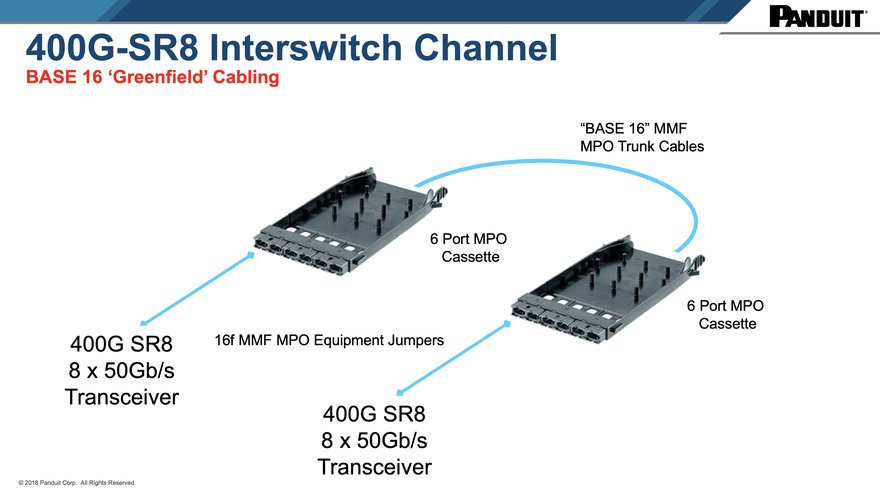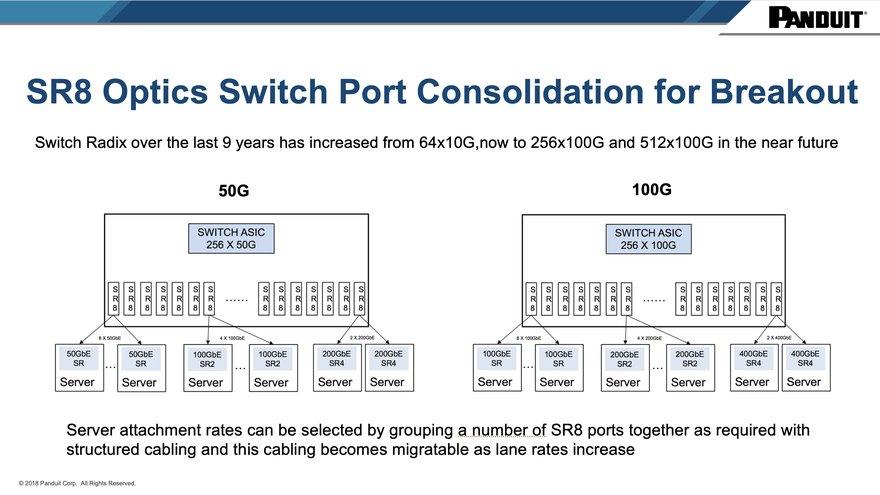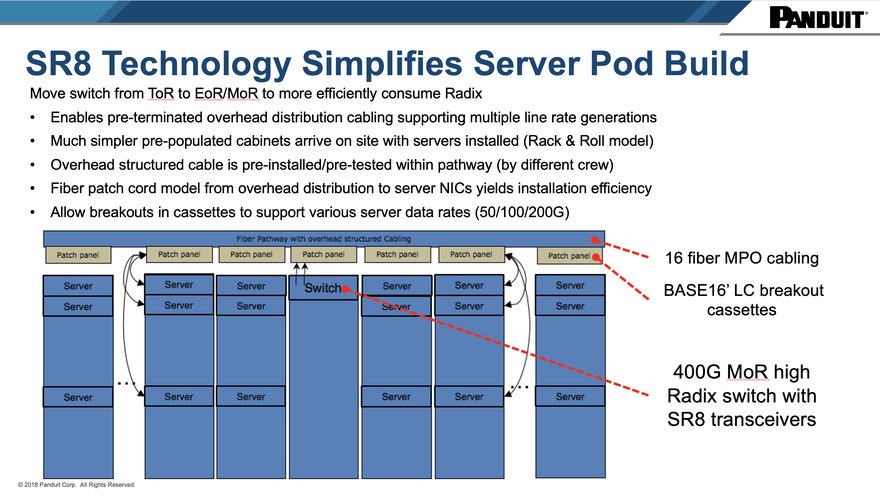Hyperscale and Edge data centers are installing or upgrading infrastructure fabrics to 400G and even 800G (2x400G) for switch to server and leaf-spine connectivity, for which there are several MMF and SMF transceiver options to choose from.
Among these options, many customers are evaluating multimode parallel optics for short-reach network connectivity. 400GBASE-SR8 transceivers over 16 parallel MMF strands (50Gbps on each strand of MMF), require Base-16 MMF structured cabling systems, providing significant value for short-reach connectivity systems interconnecting MOR/EOR switches to servers.
Newer technologies and applications that require faster interconnect, increasing bandwidth, and network capacity require innovative solutions to enable operators to offer leading-edge platforms. There is keen interest in 400GBASE-SR8 systems utilizing multimode transceivers, that for switch-to-server connections provide lower cost and power consumption than SMF alternatives such as 400GBASE-DR4.
Base-16 structure cabling, with small form factors cassettes, MPO-16, and Base-16 cabling simplify network deployment in greenfield networks as shown in Fig. 1. To take full advantage of multimode short reach variant, Base-16 interconnection with SR8 transceiver, over existing Base-12 structured cabling infrastructure conversion cassettes can be utilized.
We are currently seeing single mode traffic in terms of some customers moving from 400G to 800G (2x 400G), however, our customer interactions indicate that the multimode 16 fiber MPO modular cassette solution certainly has a place in the market, particularly for MOR/EOR switch to server interconnections due to the previously mentioned advantages. This is especially true in respect of preterm assembly and speed of deployment, with highly flexible cassette configurations.
Expanding capacity
The key benefit that enabling high density breakouts of 50G server ports using SR8 is the level of expansion if offers. When you have Base 16 fiber from an SR8 perspective it offers 50G breakout, for example, from a 400G SR8 optic, being delivered as a 32 port 1RU modular 400G switch, will then enable 256, 50G breakout ports in terms of a high Radix.
A benefit of this approach is a reduction in the number of optical links and supporting cable plant (patch panels and connectors) as the deployment is 400G to 400G and then using breakout technology to get the 50G at the top of the rack (TOR) server end without using an actual TOR switch.
This allows operators to deploy less fiber infrastructure into the data center environment. A further benefit therefore is the fourfold increase in respect of aggregator switch bandwidth, and in some situations a lower initial installed cost, depending on the SKU.
Moreover, the replacement of several TOR switches with a few MOR/EOR with more capable and efficient switches produce significant reduction in power consumption.
The 400G breakout to 50G servers appears to be a sweet spot from a multimode perspective, using a variety of options such as the conversion cassettes, for customers who want to use existing infrastructure across legacy Base-8 and Base-12 fiber cable plant in conjunction with SR8 Base-16 optics.
400G DR4 transceivers can also breakout into four streams of 100G. This can be useful to implement the spine-and-leaf connections between switches. Breakout cassettes as the one shown in Fig. 3 can be used. However, contingent on the deployment length and application, SR8 multimode can provide advantages compared to single mode fiber DR4.
SR8 technology helps to simplify the server pod build providing different options. Data centers can deploy patch panels above the servers which breakout of the 400G transceiver with Base-16 MPO coming into the fiber panel into duplex LC ports, and then use patch cable to connect to the servers at 50G as shown in Fig. 3.
Another option is to break out, with a hydra, from the Base-16 MPO delivering 50G into the server environment. An EOR/MOR Switch with 400G ports that break out onto the patch panel, feeds the servers.
These deployments enable pre-terminated overhead cable providing simplified cable distribution in pre-populated cabinets. Overhead infrastructure is advantageous in a rolling rollout environment allowing easier access to end-of-life cabinets and hardware (Fig. 4.)
Conclusion
As the data center market transitions to higher data speeds, we need to consider what solutions provide the speed and bandwidth necessary to enable those applications that require faster and larger datasets.
Essential to this is the consideration of how the devices that enable this connectivity to interoperate with existing networks, and how their introduction will move the capabilities forward.
Base-16 has a place in that discussion as business drivers for data center operator include new network upgrades and increasing bandwidth while reducing latency.
More from Panduit
-

Sponsored Connecting the boxes: Secure your data
Keeping data secure with a holistic approach to data center resilience
-

Sponsored Securing fiber densification with ODFs
Selecting the right optical distribution frame (ODF) to maximize flexibility, manageability, security and scalability in your data center
-

Sponsored Sustainability: Time to get your own blue flag
Waving the blue flag for a greener future





